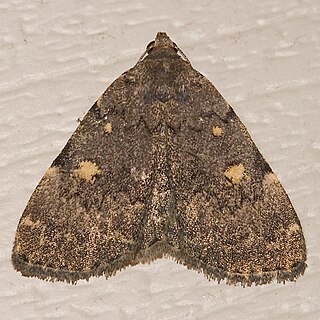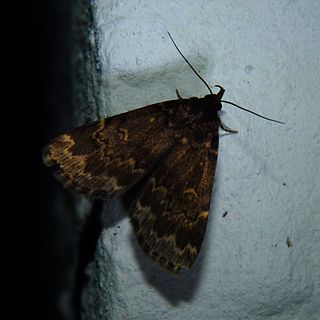
Idia is a genus of litter moths of the family Erebidae first described by Jacob Hübner in 1813.
Dichozoma is a monotypic moth genus of the family Crambidae erected by Eugene G. Munroe in 1961. Its only species, Dichozoma parvipicta, was first described by William Barnes and James Halliday McDunnough in 1918. It is found in North America, where it has been recorded from Arizona, California, Utah and Texas.

Aseptis is a genus of moths of the family Noctuidae. The genus was erected by James Halliday McDunnough in 1937.

Grotella is a genus of moths of the family Noctuidae first described by Leon F. Harvey in 1875.

Hyperstrotia is a genus of moths of the family Erebidae. The genus was erected by George Hampson in 1910.

Idia aemula, the common idia, powdered snout or waved tabby, is a litter moth of the family Erebidae. The species was first described by Jacob Hübner in 1813. It is found from Canada south to Florida and Texas. It has been reported in the Palearctic.

Idia lubricalis, the glossy black idia, is a litter moth of the family Erebidae. The species was first described by Carl Geyer in 1832. It is found from Canada south to Florida and Texas in deciduous forests.

Idia diminuendis, the orange-spotted idia, is a litter moth of the family Erebidae. The species was first described by William Barnes and James Halliday McDunnough in 1918. It is found in North America from Wisconsin to Nova Scotia, south to Florida and Texas.

Idia rotundalis, the chocolate idia or rotund idia moth, is a litter moth of the family Erebidae. The species was first described by Francis Walker in 1866. It is found from southern Canada to Florida and Texas.
Idia scobialis, the smoky idia, is a litter moth of the family Erebidae. The species was first described by Augustus Radcliffe Grote in 1880. It is found in North America from Michigan, southern Quebec and Maine, south to Florida and at least Kentucky.
Idia laurentii, the laurentine idia, is a litter moth of the family Erebidae. The species was first described by J. B. Smith in 1893. It is found in the US from central New York, south to the mountains of North Carolina.
Idia terrebralis is a species of litter moth of the family Erebidae first described by William Barnes and James Halliday McDunnough in 1912. It is found in North America, including Illinois.
Idia parvulalis is a species of litter moth of the family Erebidae first described by William Barnes and James Halliday McDunnough in 1911. It is found in North America, including its type location, the Santa Catalina Mountains in south-eastern Arizona.
Renia nemoralis, the tardy renia or chocolate renia moth, is a litter moth of the family Erebidae. It is found in the US from Illinois to south-eastern Massachusetts south to Florida and Texas. The species was first described by William Barnes and James Halliday McDunnough in 1918.

Hyperstrotia pervertens, the dotted graylet, is a moth of the family Erebidae. The species was first described by William Barnes and James Halliday McDunnough in 1918. It is found in woodlands and forests of North America from Missouri to Nova Scotia, south to Florida and Texas. It is found in New Brunswick, Nova Scotia, Quebec and Ontario in Canada. In the United States, it has been recorded in Massachusetts, Iowa, New York and South Carolina.
Comadia albistrigata is a moth in the family Cossidae first described by William Barnes and James Halliday McDunnough in 1918. It is found in North America, where it has been recorded from Arizona, New Mexico and Texas.
Hamilcara is a monotypic moth genus in the family Cossidae. Its only species, Hamilcara atra, is found in North America, where it has been recorded from Arizona. The genus and species were first described by William Barnes and James Halliday McDunnough in 1910.

Doryodes tenuistriga is a moth of the family Erebidae first described by William Barnes and James Halliday McDunnough in 1918. It is found in North America, where it has been recorded from costal Texas and Louisiana.
Phytometra apicata is a moth in the family Erebidae described by William Barnes and James Halliday McDunnough in 1916. It is found in North America.
Sericosema immaculata is a moth in the family Geometridae described by William Barnes and James Halliday McDunnough in 1913. It is found in North America.







